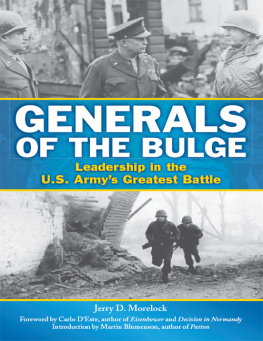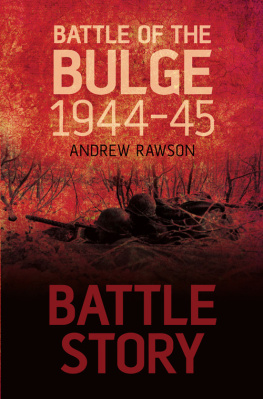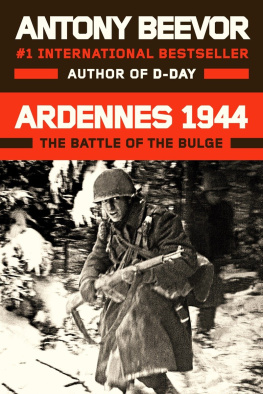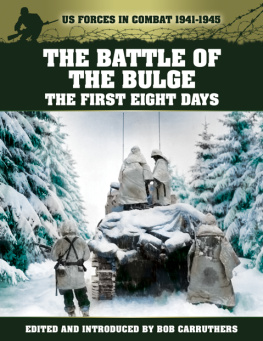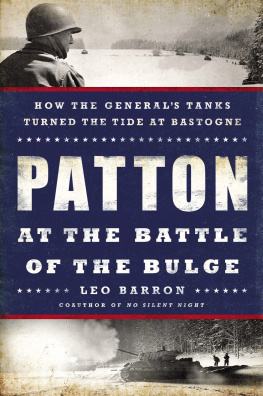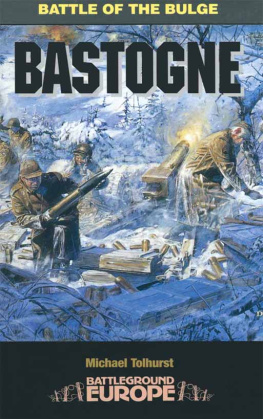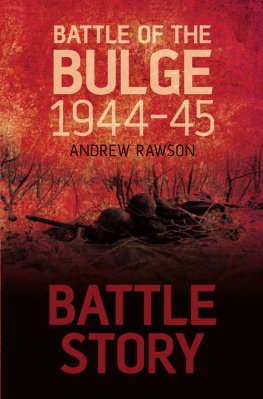ACKNOWLEDGMENTS
G enerals of the Bulge: Leadership in the U.S. Army's Greatest Battle is a significantly revised and updated edition of my 1994 book, Generals of the Ardennes: American Leadership in the Battle of the Bulge. It has been exceptionally satisfying over the years to note the number of writers and historians who have found the original version of this book to be useful, citing it in their own works. However, over the two decades since it was first published, countless books and articles on the Battle of the Bulge have appeared. Clearly, for it to remain a useful resource, this book must be revised and updated to incorporate the best and most relevant of these works, so that the examination and analysis of the subject generals is informed by new research conducted by myself and others since 1994. Therefore, I must give a collective thank you to all of my friends, colleagues, and mentors who strongly encouraged me to write this revised edition and who have unstintingly supported me in this effort.
The genesis of the original book was an idea by Lt. Col. Boyd M. Mac Harris while he was assigned to the Center for Army Leadership at Fort Leavenworth, Kansas, in 1983. Mac had just completed writing the army's principal field manual on military leadership, FM 22-100, which was directed at junior leaders, the battalion level, and below. It was Mac's inspired creation to use illustrative case studies of historical examples in that manual to help teach and drive home the lessons of combat leadership. He was then just beginning to write a new field manual, this time aimed at army senior leadership, the brigade level, and higher, and approached me to support that effort by investigating, researching, and writing illustrative case studies of some of our World War II senior leaders. The research for those cases studies encompassed examining the military careers and wartime battle leadership demonstrated by Dwight D. Eisenhower, Omar N. Bradley, William H. Simpson, Troy H. Middleton, Bruce C. Clarke, and other outstanding American commanders. Sadly, Mac's untimely death in October 1983 cut short his efforts on the senior leadership manual and robbed the army of an original and innovative thinker on leadership and command. Without Mac's inspiration, this book would not have been possible.
While researching the initial version of this book, I met three veterans of the Battle of the Bulge whose generous assistance proved invaluable in its completion. Gen. Bruce C. Clarke spent countless hours sharing his experiences of that battle and willingly opened his personal files and correspondence to me. Clarke's lifelong study of command and leadership produced a wealth of material that provided a rich source of personal and professional experiences. Col. Roy U. Clay unselfishly provided much detailed information about the 275th Armored Field Artillery Battalion's key role in the defense of St.-Vith, including his candid observations on the situation leading to the surrender of the 422nd and 423rd Infantry Regiments on the Schnee Eifel, the greatest U.S. capitulation of the European war. Colonel Clay's inspirational example stands as a model of what a battle leader ought to be. Mr. Eugene Garrett, who served in Battery B, 285th Field Artillery Observation Battalion, survived the Battle of the Bulge's most horrifying and infamous incidentthe Malmedy Massacre. Silenced for many years by having endured the grief and horror of this war crime, Mr. Garrett nonetheless recounted the details of his terrible experience to me and thereby contributed his unique knowledge and insight about what that terrible combat in the U.S. Army's greatest battle was actually like for the soldiers who fought it.
In 2005, I had the honor of meeting another veteran of the Battle of the Bulge, L. Martin Jones. As an infantry lieutenant in the 106th Division, Jones was captured when his surrounded regiment on the Schnee Eifel was surrendered by its commander; he spent the remainder of the war as a POW. Lieutenant Jones graciously agreed to a several-hour interview, during which he provided his compelling, first-hand, eye-witness account of the fighting and ultimate surrender of the 106th's regiments trapped east of St.-Vith and related his remarkable odyssey as a POW. It was a singular privilege to have known these four outstanding soldiers.
During the research and writing of the original version of this book, Generals of the Ardennes, and later when working on this revised edition, I was especially fortunate to receive the guidance, encouragement, assistance, and support of several outstanding historians and colleagues: Dr. Robert H. Berlin; Lt. Col. Roger Cirillo; Col. Peter Mansoor; Brig. Gen. Jack Mountcastle; Brig. Gen. Hal Nelson; Dr. Timothy K. Nenninger; Dr. W. Glenn Robertson; Dr. Roger J. Spiller; Brig. Gen. Bill Stofft; and Professor Ted Wilson. A special thanks is due Carlo DEste, a longtime dear friend and valued colleague whose superb biographies of Eisenhower and Patton (published after the original version of this book came out) have provided priceless additional insight into the experiences, character, and leadership of these two key Battle of the Bulge commanders and their World War II contemporaries that has proven essential in the preparation of this revised book. I am greatly honored that Carlo has written the new foreword to this edition. And I remain extremely grateful to the late Professor Martin Blumenson, who graciously agreed to write the introduction to the original edition of this book. Martin was a Patton scholar and author of two volumes of the army's official history of the war. As a U.S. Army historian in Europe during the campaigns of 19441945, Martin had personal, first-hand knowledge of many of the leaders in this book, and he very willingly shared his vast insight, ideas, opinions, and observations about World War II command and leadership with the author. Sadly, Martin passed away in 2005, and those of us who knew him lost a great friend and generous mentor.
The 1994 publication of the original version of this book, Generals of the Ardennes, would not have been possible without the unwavering commitment of National Defense University's Dr. Fred Kiley, Lt. Col. John Clements, Mr. Thomas C. Gill, and editor Mary Sommerville. This revised edition, Generals of the Bulge, owes its publication to the unwavering support of M. David Detweiler, CEO of Stackpole Books, who enthusiastically encouraged the effort to update and revise the original version. David's meticulously prepared, well-informed, and extensively-detailed suggestions for changes and additions have proven essential in creating this new edition. I also express my deep gratitude to editor David Reisch and assistant editor Brittany Stoner at Stackpole Books, and to cartographer Jason Petho and images researcher Zachary Bathon, whose superb efforts have resulted in greatly improved maps and photographs in this new edition.
Any errors of fact or judgment in this book, however, are the author's alone.
Jerry D. Morelock

An American soldier walks along a deserted road in the Luxembourg area of the Ardennes. U.S. ARMY

M4A3 Sherman tank, the principal armored fighting vehicle of World War II. Although often outclassed by some of the later German panzers, American assembly lines produced about 50,000 of these sturdy tanks during the war, a number the Germans could never hope to achieve. U.S. ARMY


